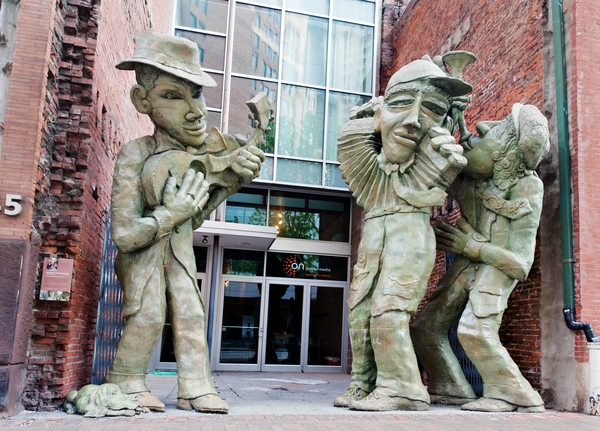
Public Art + IoT = An Engaged Civic Space
Creating a SMART infrastructure to help the City of Pittsburgh engage citizens with its memorial and public art programs -- connecting knowledge about those works and allowing active digital participation about the encounters, via relevant and economically inclusive pathways.
The City of Pittsburgh and civic stakeholders have a long-standing investment in memorials and public art. Most recently, the city released a database of memorials and public art locations. The location database is an excellent inventory tool but lacks a means to track civic engagement around these critical infrastructure investments. Civic arts engagement is broadly recognized as having a positive impact on city livability, safety, and educational achievements. However, measuring civic engagement with public art is challenging to quantify due to the lack of traditional arts data points such as ticket sales, membership information, and dedicated social media channels.
This project offers a technology-based engagement platform that allows for data collection which through subsequent analysis will allow for greater understanding of the impact of these installations on the citizenry and city as a whole. By utilizing smart technology like beacons and QR codes, and deploying social engagement tools, such as unique hashtags campaigns, Pittsburgh’s system of memorials and public art can not only create and share a database of knowledge with users but engage them with the art, and track who they are, how they engage, and why they view the works. This project’s measures focus on data that provides insight into social, economic and transportation impacts of these works, yet other impacts are likely and will be discovered throughout the course of the research. If successful, this system would create a model for public art and civic engagement that could easily replicated by cities throughout the US and around the world.
Project Update (December 2018)
Over the last 3 months, researchers have discovered a myriad of technology solutions at work in the public art space. Some are driven specifically by municipalities, others are created through municipal partnerships, others are created by professionals in the field supporting public art broadly and others are citizen-created solutions to draw attention to the power of public art. Interestingly, there is nocorrelation between the technology and the driver (funder) of the solution.
Two overarching lessons were gleaned from the research:
1. The user MUST come first in designing the solution
2. If Pittsburgh doesn’t move forward, then passionate citizens will (and already have as demonstrated by a simple search on Facebook both individuals and companies trying to fill the void)
The most common pathways for engagement appear to be web-based, map-based, social media with chatbots or custom apps.
Web Based: Web based solutions may stand alone, or may be formatted “wiki style” and provide background information for an app-based solution or responsive web-site that functions like an app. These solutions require something that directs the user to the website with a specific URL. Common relays include QR codes. Furthermore, once on a web-site, chatbots can be installed for simple decision tree FAQ about art or more interactive question responses.
Map Based: Smartphones carry existing mapping apps that can provide information, for example, “what’s near me” information can be layered with public art gps points, information and pictures. Cameras on phones are using gps, and in the future may offer connections with map-based data that will provide integrated image recognition opportunities for information relay and engagement.
Social Media Solutions: 85% of citizenry is habituated to social media, and while social media seems to have plateaued in the United States due to recent scandals, Facebook, Twitter and Instagram are common engagement pathways. A Facebook Messenger chatbot can serve as a source for information with an appropriate decision tree construction. Furthermore, an active Instagram account (#pittsburghpublicart already exists) can create active and exciting opportunities for engagement with citizens.
App Based: App based solutions present the opportunity for patrons to have a full public art experience at their fingertips. Apps present the option for a variety of integrated educational and social engagement features. However, without a full city-wide use value an app is the least likely to be used in the panoply of options. Hence, a full-app design solution is only recommended if a city-wide solution is created (adding quality of life aspects to the current city services app).
Next Step: Prototyping
As identified in the Scope of Work, our next step in the project will be working with our partners in prototyping mapping, web, app, and social solutions that meet the identified goals for civic engagement. The necessary data analysis is already complete. Added to that will be customer journey maps to hypothesize and test prototype solutions. Once the feedback is complete, final analysis of data collected will be analyzed for a final report.
Project Partners
Arts Management and Technology Laboratory
https://amt-lab.org/
Office of Public Art and Civic Design, City of Pittsburgh
http://pittsburghpa.gov/dcp/pa-cd
GIS team, City of Pittsburgh
http://pittsburghpa.gov/dcp/gis
Greater Pittsburgh Arts Council, Public Art Leads
https://www.pittsburghartscouncil.org/public-art
Project Team
Brett Crawford
Project Lead, Associate Teaching Professor of Arts Management
Jenee Iyer
Joint Degree Graduate Student, Master of Arts Management and University of Pittsburgh Law School, t
Ashley Kowach
Master of Arts, Arts Management
Fall Semester Students
Michaela White, Master of Arts, Arts Management
Lauren Saunders, Master of Arts, Arts Management
Emily Halpern, Master of Arts, Arts Management
Stephen Michaels, Undergraduate, College of Fine Arts
